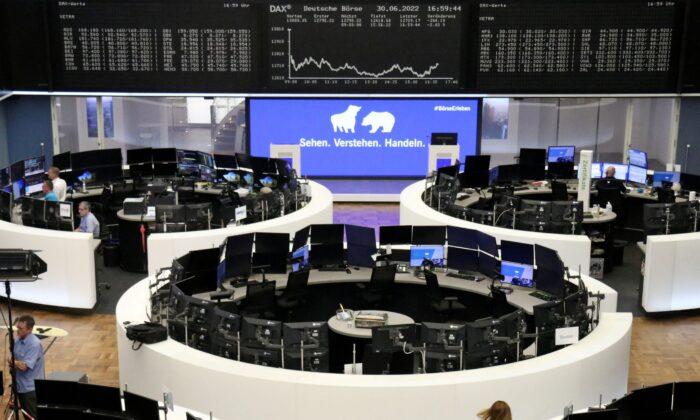LONDON—European equities slipped slightly on Friday but were still set for a weekly gain, while traders waited for U.S. jobs data due later in the session to give clues as to the health of the world’s largest economy.
The MSCI world equity index, which tracks shares in 47 countries, was up 0.2 percent and on track for a weekly gain of 0.7 percent—marking its third consecutive week of gains.
Asian shares rose overnight but at 0823 GMT the STOXX 600 was down 0.1 percent, France’s CAC 40 and Germany’s DAX were flat. London’s FTSE 100 was down 0.2 percent.
Central banks around the world have been raising interest rates in an attempt to limit surging inflation, but European stocks have recovered to near two-month highs this week.
“Equity futures have grown comfortable with the idea that interest rate hikes that the central banks are putting through will be sufficient to contain inflation in the longer term,” said Kiran Ganesh, multi-asset strategist at UBS.
But other asset classes are reflecting a slowdown.
The closely watched part of the U.S. Treasury yield curve measuring the gap between yields on two- and 10-year Treasury notes reached 39.2 basis points on Thursday, the deepest inversion since 2000.
An inverted yield curve is often seen as an indicator of a future recession.
Oil rose, recovering after the previous session saw prices hit their lowest levels since February. Concerns about supply shortages were enough to cancel out fears of weakening fuel demand.
Global crude oil markets remained firmly in backwardation, where prompt prices are higher than those in future months, indicating tight supplies.
Investors will look to U.S. jobs data to see if the U.S. Federal Reserve’s aggressive pace of rate hikes is starting to cause economic growth to slow.
The data is expected to show that nonfarm payrolls had increased by 250,000 jobs last month, after rising by 372,000 in June.
“Until now, markets have been responding to stronger economic data as good news. But at some point, they will maybe question whether the Fed’s tightening is having the desired effect if the economy remains strong,” wrote ING economists in a note to clients.
“At that stage, they could start to fret that rates may rise higher, or stay higher for longer.”
UBS’s Ganesh said that a nonfarm payrolls figure in the range of 200,000 to 300,000 would be consistent with a “soft landing” for the economy, while a higher figure would suggest that the Fed needed to raise interest rates more to contain demand.
Data on Thursday showed that the number of Americans filing new claims for unemployment benefits had increased last week, suggesting that a weakening in the labor market might already be underway.
Cleveland Fed President Loretta Mester struck a hawkish tone on Thursday, saying that the Fed should raise interest rates to above 4 percent to bring inflation back down to target.
The U.S. dollar index was up around 0.2 percent and the euro was down 0.2 percent at $1.02265. The Australian dollar, which is seen as a liquid proxy for risk appetite, was down 0.1 percent at $0.6958.
The British pound was down 0.1 percent at $1.215.
The Bank of England raised interest rates by the most in 27 years on Thursday and warned that a long recession was coming.
European government bond yields were mostly 1 to 2 basis points higher, with the benchmark German 10-year yield at 0.812 percent.
German industrial production posted an unexpected but modest increase in June, official data showed.






Friends Read Free